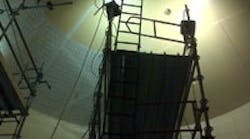During the September 2008 American Society of Mechanical Engineers (ASME) Bioprocessing Equipment (BPE) meeting, members of the Polymer Materials subcommittee were notified of an epoxy coating failure inside a crucial tank at a major bioprocessing facility in California. The loss of this tank, which served as the primary process water holding vessel for the plant, caused a very costly shutdown of the manufacturing line.
It wasn’t clear why an epoxy coating originally had been specified. After all, the process water undergoes ozone treatment to control bacteria buildup and, per ASME BPE guidelines, this should have ruled out using such a coating.
The plant wanted to get back into production as soon as possible and sought advice about a remedy for the tank problem. Several of the subcommittee members recommended a Kynar polyvinylidene fluoride (PVDF) lining.
The situation was referred to Fisher Co., North Salt Lake, Utah, a major fluoropolymer tank lining and coating company. Its first step was to install a temporary vessel to get production back onstream. After this, the failed vessel could be lined with Kynar PVDF.
Fisher supplied a Kynar PVDF dual-laminate temporary vessel. Piping-in and inspection took place simultaneously. The time from when the problem first was identified to when the facility resumed production was only a few days. The tank performed as expected until the permanent one was reinstalled.
LONG-TERM SOLUTION
With the temporary vessel in place, attention turned to removing the failed epoxy coating and verifying the structural integrity of the permanent tank. First, its interior was blasted to a “white metal” finish, removing the epoxy, all corrosion products and any other surface contamination. Next, a coating was applied to the freshly blasted surface to prevent oxidation. At this point, the tank was ready for PVDF lining installation.
It was crucial to choose the proper sheet. The lining needed excellent flexibility, to cope with the differential thermal expansion and contraction between it and the metal. Fisher chose Kynar Flex 2850 fabric-backed sheet from Laminations Co., Archbald, Pa., for its ease of installation and welding.
The lining process began with bonding the sheets to the vessel (Figure 1). This required great care, to provide the proper gap between the sheets for subsequent welding and to avoid any air entrapment or unbonded areas between the sheet and vessel. After the lining was in place and the adhesive had cured, the gaps between the sheets were welded. Then, the welds were visually inspected for defects and spark tested.
The lining passed all quality tests and the vessel was put back into service in October 2008. It has performed without issue since then and should provide satisfactory service for many years.
LESSON LEARNED
The key takeaway from this mishap is to fully investigate a coating or lining before using it. Despite claims to the contrary, epoxy doesn’t always stand up to ozone-treated water. In addition, extractable materials in the epoxy, such as bisphenol A, may wind up in the water. So, it’s questionable whether the epoxy satisfies the ASME BPE specification, which clearly defines the requirements for materials that come into direct and indirect contact with a biopharmaceutical product.
HOWARD FISHER is general manager at Fisher Co., North Salt Lake, Utah. TED HUTTON is a senior market specialist for Arkema, Inc., King of Prussia, Pa. E-mail them at [email protected] and [email protected].
